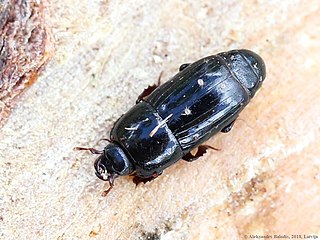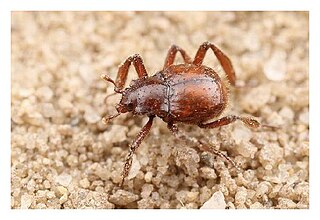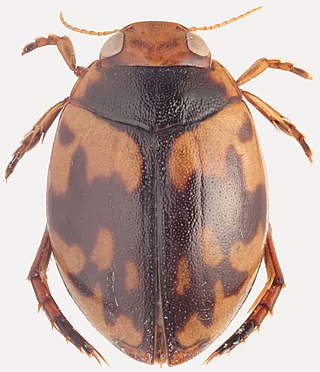
Histerinae is a subfamily of clown beetles in the family Histeridae. There are more than 140 genera and 2,000 described species in Histerinae.

Haeteriinae is a subfamily of clown beetles in the family Histeridae. There are more than 110 genera and 330 described species in Haeteriinae.

Hyphydrini is a tribe of predaceous diving beetles in the family Dytiscidae. There are about 16 genera and more than 390 described species in Hyphydrini.

Gyrinus minutus is a species of whirligig beetle in the family Gyrinidae. It is found in North America and Europe.

Cybistrini is a tribe of predaceous diving beetles in the family Dytiscidae. There are 7 genera and 128 described extant species in Cybistrini. The same set is also called Cybistrinae by authors viewing it as a subfamily of Dytiscidae.

Dytiscus habilis is a species of predaceous diving beetle in the family Dytiscidae. It is found in North America from Oklahoma to Arizona south throughout Mexico to Guatemala; it is the only Dytiscus species found in the Neotropics.
Elodes apicalis is a species of marsh beetle in the family Scirtidae. It is found in North America.
Bembidion bimaculatum is a species of ground beetle in the family Carabidae. It is found in North America.
Cylindera celeripes, the swift tiger beetle, is a species of flashy tiger beetle in the family Cicindelidae. It is found in North America.
Mychocerus discretus is a species of minute bark beetle in the family Cerylonidae. It is found in North America.

Endeitoma granulata is a species of cylindrical bark beetle in the family Zopheridae. It is found in North America.
Rhizophagus dimidiatus is a species of root-eating beetle in the family Monotomidae. It is found in North America.
Rhizophagus grouvellei is a species of root-eating beetle in the family Monotomidae. It is found in North America.
Rhizophagus cylindricus is a species of root-eating beetle in the family Monotomidae. It is found in North America.

Gibbium aequinoctiale, the smooth spider beetle, is a species of spider beetle in the family Ptinidae. It is found in the Caribbean, Europe and Northern Asia, Central America, North America, and South America. It has been reported from many parts of the world as Gibbium psylloides.
Rhizophagus sculpturatus is a species of root-eating beetle in the family Monotomidae. It is found in North America.
Rhizophagus minutus is a species of root-eating beetle in the family Monotomidae. It is found in North America.
Rhizophagus remotus is a species of root-eating beetle in the family Monotomidae. It is found in North America.
Rhizophagus sayi is a species of root-eating beetle in the family Monotomidae. It is found in North America.

Rhizophagus parallelocollis, the graveyard beetle, is a species of root-eating beetle in the family Monotomidae. It is found in North America and Europe.








